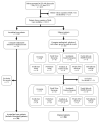Variation in Seeking Care for Cardiovascular Disease and Ambulance Utilization among Migrants in Australia: Time, Ethnicity, and Delay (TED) Study III
- PMID: 35162538
- PMCID: PMC8834978
- DOI: 10.3390/ijerph19031516
Variation in Seeking Care for Cardiovascular Disease and Ambulance Utilization among Migrants in Australia: Time, Ethnicity, and Delay (TED) Study III
Abstract
Insight into differences in seeking medical care for chest pain among migrant populations is limited. This study aimed to determine ethnic differences in seeking care behaviors and using ambulances among migrants compared to an Australian-born group. A total of 607 patients presenting with chest pain to a tertiary hospital between 1 July 2012 and 30 June 2014 were randomly selected. Data from the emergency department dataset and medical record reviews were collected and linked for analysis. The migrant group was stratified into nine ethnic groups for analysis based on the Australian Standard Classification of Cultural and Ethnic Groups. The overall median prehospital delay time was 3.7 (1.5, 10.7) h, which ranged from 2.5 (1.0, 10.7) (Southern and Eastern European group) to 6.0 (2.3, 20.6) (Sub-Saharan African group). The median decision time was 2.0 (0.8, 7.9) h, which ranged from 1.5 (Australian-born group) to 4.5 h (Sub-Saharan African group). Five ethnic groups had significantly longer decision times compared to the Australian-born group. Decision time accounted for 58.4% of pre-hospital delay time. Migrant patients were 60% less likely to seek care for chest pain within one hour (odds ratio 0.40, (0.23-0.68), p = 0.001). There was no significant difference in ambulance utilization between migrant and Australian-born groups. In conclusion, ethnic differences in seeking care for chest pain do exist, and ethnicity plays a vital role in a longer delay in seeking care. To reduce the delays and improve patient outcomes, appropriate health campaigns focusing on ethnic differences among migrant populations and normalizing cultural competency into practice are recommended.
Keywords: ambulance utilization; chest pain; culturally and linguistically diverse; decision time; delay time; ethnicity; migrant; prehospital delay; seeking medical care.
Conflict of interest statement
The authors declare no conflict of interest.
Figures



Similar articles
-
Presenting characteristics and processing times for culturally and linguistically diverse (CALD) patients with chest pain in an emergency department: Time, Ethnicity, and Delay (TED) Study II.Int J Cardiol. 2016 Oct 1;220:901-8. doi: 10.1016/j.ijcard.2016.06.244. Epub 2016 Jun 28. Int J Cardiol. 2016. PMID: 27404505
-
Global review of delay time in seeking medical care for chest pain: An integrative literature review.Aust Crit Care. 2017 Jan;30(1):13-20. doi: 10.1016/j.aucc.2016.04.002. Epub 2016 Apr 23. Aust Crit Care. 2017. PMID: 27117387 Review.
-
Sub-Saharan African migrant youths' help-seeking barriers and facilitators for mental health and substance use problems: a qualitative study.BMC Psychiatry. 2016 Aug 2;16:275. doi: 10.1186/s12888-016-0984-5. BMC Psychiatry. 2016. PMID: 27484391 Free PMC article.
-
Exploring equity in cancer treatment, survivorship, and service utilisation for culturally and linguistically diverse migrant populations living in Queensland, Australia: a retrospective cohort study.Int J Equity Health. 2023 Sep 1;22(1):175. doi: 10.1186/s12939-023-01957-9. Int J Equity Health. 2023. PMID: 37658395 Free PMC article.
-
Migration and health: exploring the role of migrant status through register-based studies.Dan Med J. 2015 Apr;62(4):B5068. Dan Med J. 2015. PMID: 25872539 Review.
Cited by
-
The mortality risk after myocardial infraction in migrants compared with natives: a systematic review and meta-analysis.Front Cardiovasc Med. 2023 May 24;10:1101386. doi: 10.3389/fcvm.2023.1101386. eCollection 2023. Front Cardiovasc Med. 2023. PMID: 37293275 Free PMC article. Review.
-
Health Information Seeking Behavior and Health Information Preferences Among Ethnically and Socioeconomically Diverse Patients and Communities: A Qualitative Study.J Prim Care Community Health. 2025 Jan-Dec;16:21501319251332048. doi: 10.1177/21501319251332048. Epub 2025 May 14. J Prim Care Community Health. 2025. PMID: 40367279 Free PMC article.
-
Exploring factors influencing time from dispatch to unit availability according to the transport decision in the pre-hospital setting: an exploratory study.BMC Emerg Med. 2024 Apr 29;24(1):77. doi: 10.1186/s12873-024-00992-1. BMC Emerg Med. 2024. PMID: 38684980 Free PMC article.
-
Chest pain in a multi-ethnic population: A community-based study on sex differences in chest pain prevalence and care contacts.Int J Cardiol Cardiovasc Risk Prev. 2024 Dec 17;24:200361. doi: 10.1016/j.ijcrp.2024.200361. eCollection 2025 Mar. Int J Cardiol Cardiovasc Risk Prev. 2024. PMID: 39807448 Free PMC article.
References
MeSH terms
LinkOut - more resources
Full Text Sources

